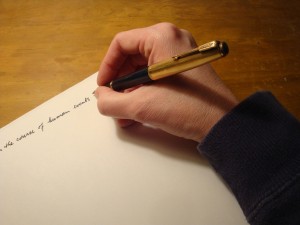I like to write longhand. My preference is to use a fountain pen, but in many respects a fountain pen seems too lofty, too sacred, if you will, to be put to profane use. So, for mundane, everyday writing I utilize a pencil.
In an age where computers are ubiquitous and schoolchildren are scarcely taught cursive—the rationale being that typing is a more practical skill for the digital age and people won’t need to write by hand anymore—the notion of writing longhand seems quaint, if not heterodox. Why bother? What’s the point? Isn’t it a waste of time, especially if you’re planning on typing up a manuscript later?
Well, no, I don’t think so. There is so much that is lost when one neglects writing longhand.
Being able to write on paper is inherently liberating. You aren’t locked into a rigid array of pixels dictating that you must live in a rectilinear world. Writing on paper gives you the freedom to write left to right, right to left, up and down, down and up, backwards, diagonally, circularly, in between the lines, in the margins, wherever you desire and however you desire. You can overcome a bout of writer’s block by doodling in the middle of your opus, should you choose, rather than sit there and endure the insulting mockery of a blinking cursor. When you realize your writing is flat and clunky and wholly unacceptable, you can start over with a fresh piece of paper after first having derived satisfaction from marking the offensive tripe with a huge “X.”
The act of writing on paper is a sensory experience, involving four of the five senses. You can see the strokes forming letters and words as you manipulate your writing instrument, resulting in a page full of penmanship that, if not beautiful with well-formed letters, is at least uniquely yours. You can feel the texture of the paper, whether it be high-quality linen stationery or cheap recycled paper with 80% post-consumer content; you can feel the smooth wood of a Ticonderoga, the rubber grip of a Pentel mechanical, or the balanced weight of a Parker “51.” You can hear the scritch-scratch of your pencil or fountain pen as it leaves the marks of your thoughts on the paper. And you can smell the wood shavings of a newly-sharpened pencil, the rubber of a recently used Pink Pearl, or the ink of a freshly written note.
We admire those who have mastered the calligrapher’s brush. Beautiful writing bespeaks grace and elegance. Someone receiving a handwritten note or hand-lettered invitation recognizes the time and effort inherent in such communication, the writer having thus chosen to share a bit of his soul.
Writing with a computer, in contrast, lacks this intimacy. The computer is a mediator between you and your words, allowing you to see but not feel your words, imposing soulless uniformity through the use of standardized, ubiquitous fonts. There is no room for individuality, no room for variation, no room for deviation. With a computer, you cannot tell if the words were scribbled in haste, written in excitement, or penned with the deliberate movements of the very young or very old. You cannot tell if the person learned Gothic or Spencerian script, or wrote in Zaner-Bloser, the Palmer method, or D’Nealian.
With computers, a thousand monkeys may eventually be able to pound out Shakespeare, but limit these simians to a pen, and never would they be able produce so much as a simple sonnet. It is said that one of the chief differences between man and beast is the invention and use of tools. Perhaps with computers we have come full circle—it shall be the writing instrument that distinguishes the civilized from the uncivilized.
So celebrate your humanity, your individuality, your civility—pick up a pen and write!

